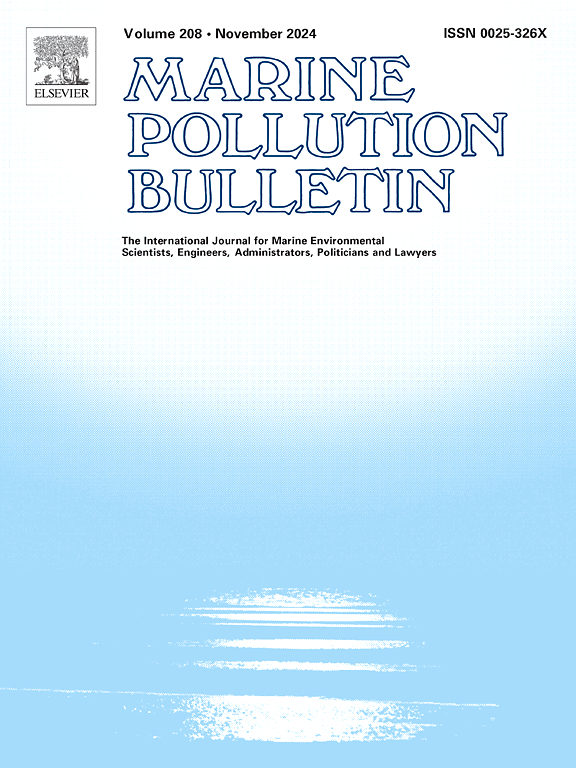Emerging contaminants as indicators of short-term environmental changes in an eutrophicated coastal lagoon
IF 5.3
3区 环境科学与生态学
Q1 ENVIRONMENTAL SCIENCES
引用次数: 0
Abstract
This research aimed to assess the potential of emerging contaminants as environmental quality indicators for short-term monitoring programs, in contrast with traditional contaminants. Thirteen sediment samples from from Piratininga, a coastal lagoon subjected to anthropogenic impact, were analyzed for the following compounds: napropamide, diclofenac, naproxen, triclosan, ibuprofen, 17β-estradiol, bisphenol A, nadolol, ethofibrate and carbamazepine. The developed method, which included solid phase extraction, derivatization, and analysis by gas chromatography–mass spectrometry, demonstrated robustness and suitability with quantification limits between 0.32 and 1.49 ng g−1. The concentrations of etofibrate, nadolol, napropamide and diclofenac were below the quantification limits for all the analyzed samples. The highest concentration was reported for bisphenol A (4.76 ± 0.44 ng g−1), followed by 17β-estradiol (2.88 ± 0.65 ng g−1), ibuprofen (2.70 ± 1.67 ng g−1) and triclosan (1.5 ± 0.43 ng g−1). The detected concentrations, spatial distribution, and local climatic conditions with distinct dry and wet seasons indicate the feasibility of biannual environmental quality monitoring. By evaluating the concentrations and statistical treatment, the use of contaminants of emerging concern as short-term indicators proved promising, leading to an optimized monitoring program from nine to three compounds (bisphenol A, ibuprofen and triclosan) and a sampling grid reduced from 13 to 4 points.
作为富营养化沿海泻湖短期环境变化指标的新污染物。
与传统污染物相比,本研究旨在评估新出现的污染物作为短期监测计划的环境质量指标的潜力。研究人员对来自皮拉蒂尼纳(一个受人类活动影响的沿海泻湖)的 13 份沉积物样本进行了分析,以检测以下化合物:萘普酰胺、双氯芬酸、萘普生、三氯生、布洛芬、17β-雌二醇、双酚 A、纳多洛尔、乙福贝特和卡马西平。所开发的方法包括固相萃取、衍生化和气相色谱-质谱分析,结果表明其稳健性和适用性,定量限在 0.32 至 1.49 纳克 g-1 之间。在所有分析样品中,依托贝特、纳多洛尔、萘普酰胺和双氯芬酸的浓度均低于定量限。双酚 A 的浓度最高(4.76 ± 0.44 纳克/克-1),其次是 17β-estradiol (2.88 ± 0.65 纳克/克-1)、布洛芬(2.70 ± 1.67 纳克/克-1)和三氯生(1.5 ± 0.43 纳克/克-1)。检测到的浓度、空间分布以及当地干湿季节分明的气候条件表明,一年两次的环境质量监测是可行的。通过对浓度进行评估和统计处理,使用新出现的污染物作为短期指标被证明是有前景的,从而优化了监测计划,将九种化合物减少到三种(双酚 A、布洛芬和三氯生),采样网格也从 13 个点减少到 4 个点。
本文章由计算机程序翻译,如有差异,请以英文原文为准。
求助全文
约1分钟内获得全文
求助全文
来源期刊

Marine pollution bulletin
环境科学-海洋与淡水生物学
CiteScore
10.20
自引率
15.50%
发文量
1077
审稿时长
68 days
期刊介绍:
Marine Pollution Bulletin is concerned with the rational use of maritime and marine resources in estuaries, the seas and oceans, as well as with documenting marine pollution and introducing new forms of measurement and analysis. A wide range of topics are discussed as news, comment, reviews and research reports, not only on effluent disposal and pollution control, but also on the management, economic aspects and protection of the marine environment in general.
 求助内容:
求助内容: 应助结果提醒方式:
应助结果提醒方式:


